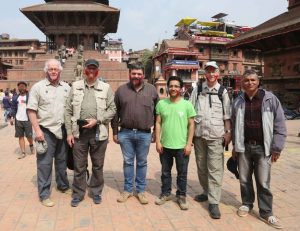W
ild elephants attacking people, damaging houses, eating crops. Tigers killing people, leopards preying on livestock. This is the almost daily practice in some part of southern Nepal: the ever-increasing ‘human wildlife conflict’. A striking example is that of Indra Acharya, who was raided by an elephant during his wedding night in his cottage at the edge of the Bardiya National Park. A wild tusker did not leave any stone of Indra’s house standing, so that the young couple barely escaped. A disturbing event, to say the least. Indra’s comment was indicative of the resilience of the Nepalese: “You know, it was my honeymoon and this elephant was probably a little jealous…”
For how long can this flexibility last? Double the Tiger Number is our aim … but without the support of the local communities we won’t achieve this. Therefore, the Himalayan Tiger Foundation is focusing on this aspect as well, with the support of two Nepalese PhD students.
During a warm afternoon in Bardiya National Park, in the pleasant shadow of the Karnali Lodge, we drink tea after an adventurous day in the jungle. ‘We’ being: Baburam Lamichhane of the Nepal Trust Nature Conservation, Subodh Upadhyaya of the Kathmandu University – both PhD students at Leiden University – and their supervisors, professors Hans de Jongh and Gerard Persoon.
Baburam, tell us about your PhD studies. “I am studying the human-carnivore interaction, specifically of tigers and leopards, to see how these animals are interacting with each other in the first place, and how the presence of these carnivores is affecting the people around Chitwan National park. Are there attacks on humans? How about livestock depredation?”
Can you share some conclusions at this stage? “We analysed the problem-causing tigers in Chitwan, to determine if specific groups or tigers have a higher probability of getting involved in conflicts with humans. From 2007 to 2016 we identified a total of 22 such tigers, including 13 that killed humans, 6 that were serial livestock killers and 3 that threatened human safety. 13 of these tigers were ‘controlled’ or killed, and 4 were relocated. We compared these numbers with Chitwan’s total tiger population – obtained from camera trapping – and we found that less than 5% were involved in conflicts.”
What kind of tigers are these? “Tigers who are not able to hold their own territory in the ‘core area’ of the National Park, are involved in these conflicts – they are pushed out of the forest. We also see young tigers searching for new territory. And we see physically injured tigers, who cannot hunt on wild prey anymore. These animals are coming into the buffer zones and attack people or livestock.”
What is the role of leopards? “Leopards are also attacking livestock. Generally there are more attacks on humans by tigers, but the overall picture is that conflicts with leopards are on the rise, especially in Chitwan where in recent years there has been more livestock-killing by leopards than by tigers.”
Are you also studying the impact of wild elephants and rhinos? “I included all animals which may cause conflicts, like elephant, rhinos, sloth bear. I found that the number of conflicts by rhinos is even higher than by tigers. In recent years the number of attacks by elephant has also been quite high.”
Subodh, you are also studying human wildlife conflict here in Bardiya, 200 km west of Chitwan. What are your findings? “When the number of tigers in the park increases, we see that leopards are pushed from the park. I want to study that aspect too, for which I am using a questionnaire survey. I’m interviewing all people around the park. Then a second aspect: I’m looking into the diet of tiger and leopard. And third: I am also analysing the camera trap data of 2013 and 2016 and comparing them. The general impression is now that leopards are the main conflict animals in Bardiya.
My diet studies show that tigers are mostly confined to inside the park – they do not come outside and they don’t prey on domestic animals. The diet of tiger is mainly deer – I came across only one buffalo that was in the corridor-area linking Bardiya National Park with the Katarniaghat Wildlife Sanctuary in India.”

victim of elephant attack
It is known that people are killed by wild elephants. Are you also studying the problem with wild elephants? “My study is mainly related to carnivores. But we know that the wild elephants are the major conflicting animals in Bardiya at the moment and that there are many human casualties caused by elephants; more than by tigers and leopards. The same applies to the destruction of houses and crops.”
Hans, as the supervisor of these PhD students together with Gerard Persoon, may I ask what is your overall impression of Nepal’s wildlife protection? “I worked a lot in Africa and Indonesia, and I must say that I’m really impressed by the impact of nature conservation in Nepal. I think that Nepal is doing an excellent job – setting an example for other countries.”
And Gerard, what is your role? “As an anthropologist I have worked for the greater part of my life in nature conservation projects – not from the biological point of view but always from the perspective: ‘What does nature conservation mean for local communities’? What is the impact of national parks, how can conflicts be mitigated? Maybe it is because I’m an anthropologist, but I do believe that nature conservation is much more about managing people than about managing animals. Animals take care of themselves. The social, economic and ethical aspects of nature conservation… that is the crucial thing. You cannot solve these kinds of conflict-problems by mere hard-core biological or ecological approaches. You need a multidisciplinary approach.”

Gerard Persoon, Hans de Iongh, (unknown), Babu Ram Lamichhane, (unknown), Subodh Upadhyaya during Holi Festival
Babu Ram, Subodh, any solution for mitigating the human wildlife conflict? “Removal of the dangerous animals may reduce the conflict and decrease the anger of villagers. Tigers, especially dispersing sub-adults, need to be monitored – for example by using camera traps or satellite telemetry in habitat edges where high interaction between people and tigers occurs. Information about such tigers should be communicated through a participatory early warning system. Facilitating dispersal of such tigers through corridors can also reduce risks of conflict.” “Last but not least… awareness programmes focusing on the most vulnerable communities will be helpful in reducing human and livestock mortality by tigers. This system should include regular monitoring and timely identification of problem tigers, followed by decisive management action: either remove the tiger or encourage local people to modify their behaviour to reduce the risk of conflict…. or both.”

